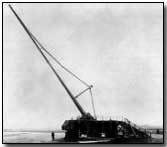Encyclopedia - The Paris Gun
 The Paris Gun - properly
called the Kaiser Wilhelm Geschutz - was so-named for its sole purpose of
shelling Paris from extreme distances starting from March 1918. A
behemoth, the Paris Gun - regarded by many as the ancestor to the German V3 -
was capable of firing shells into the stratosphere from locations as far as
131km from Paris.
The Paris Gun - properly
called the Kaiser Wilhelm Geschutz - was so-named for its sole purpose of
shelling Paris from extreme distances starting from March 1918. A
behemoth, the Paris Gun - regarded by many as the ancestor to the German V3 -
was capable of firing shells into the stratosphere from locations as far as
131km from Paris.
Designed and operated by the German Navy and manufactured by the German munitions firm of Krupp, some seven 210mm guns were made using bored-out 380mm naval guns, each fitted with special 40 metre long inserted barrels. However with only two railway gun mountings actually available just three of the guns were ever in use at any one time, fired from the Forest of Coucy.
Such was the rapid wear and tear of firing its 120kg shells, each requiring a 180kg powder charge, towards Paris - the aim was often wild - that the gun's lining required reboring after approximately 20 shots. Indeed, after every firing the succeeding shell needed to be of slightly greater width.
An undoubted sensation when first deployed (at 7.18 on the morning of 21 March 1918) the appearance of heavy shells in Paris caused initial and widespread alarm among its inhabitants which nevertheless quickly subsided. Once fired a shell took 170 seconds to reach Paris, rising as high as 40 km above the earth.
For all its power the gun had little actual effect on the course of the war, with just 367 shells fired between March and August - a figure disputed by the French who cited 320, of which 183 landed within the city's boundaries.
Casualties of the gun's use ran to 256 deaths and 620 wounded, with 88 killed and 68 wounded on Good Friday 1918 alone when a shell landed on the church of St. Sepulchre, causing its collapse while a service was in progress.
The Paris Gun was nevertheless a notable propaganda success at home in Germany. The Allies searched in vain for the guns during the German retreat of August 1918 onwards and after the armistice, but in vain. No example of the Paris Gun has been located then or since although U.S. forces located one of the gun's spare mountings.
Click here to read an account of an early destructive use of the gun written by the U.S. Ambassador to Paris, William G Sharp. Click here to read a British press report of its use.
'Billy' was the Australian nickname for a cooking-pot or can.
- Did you know?
